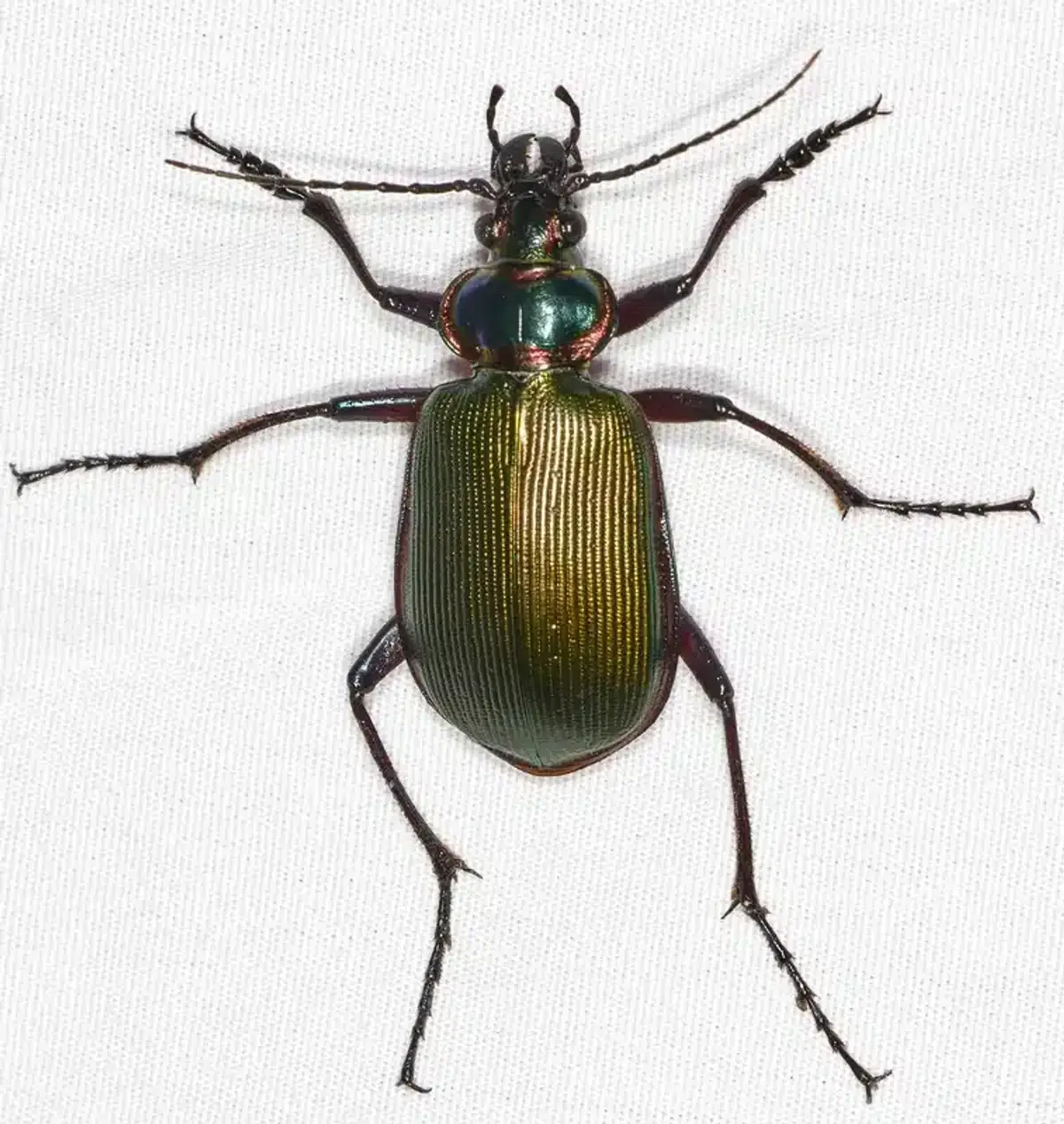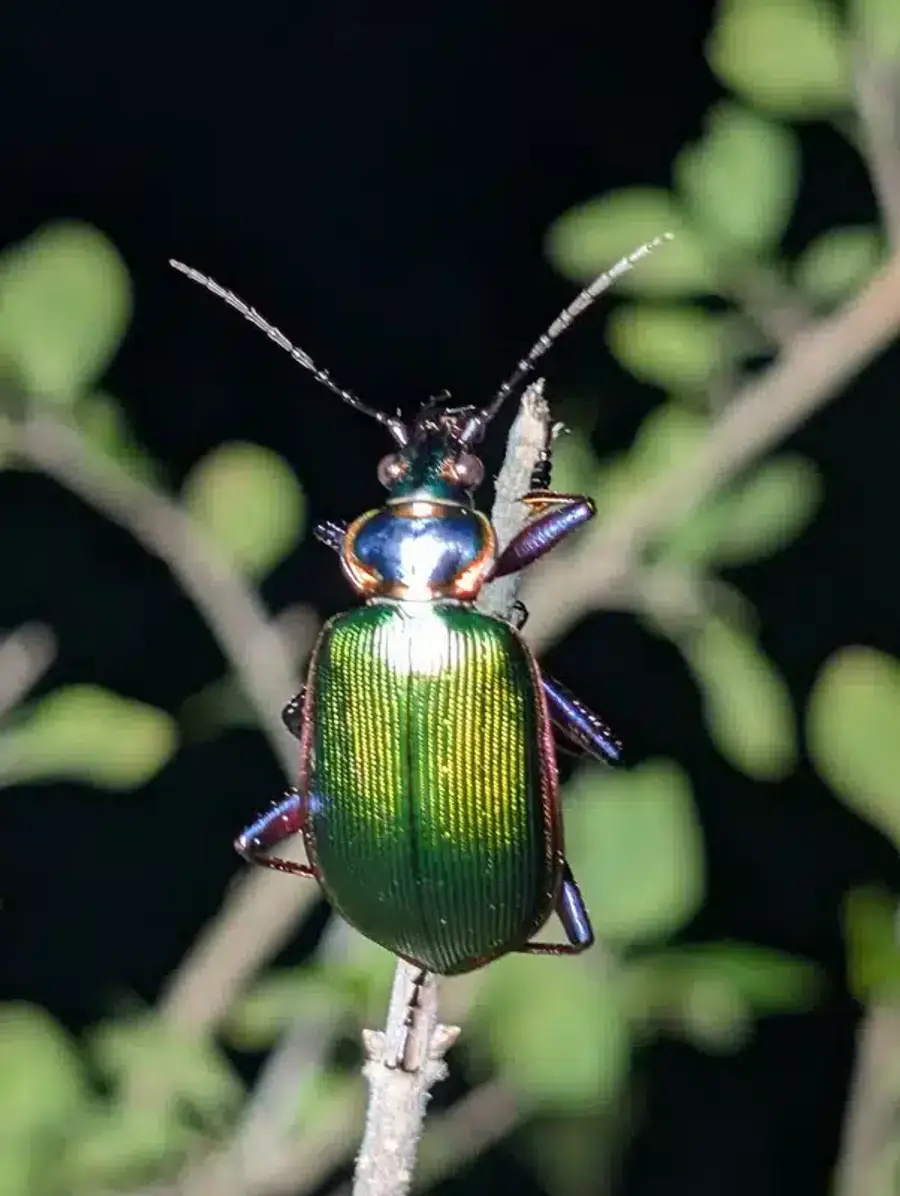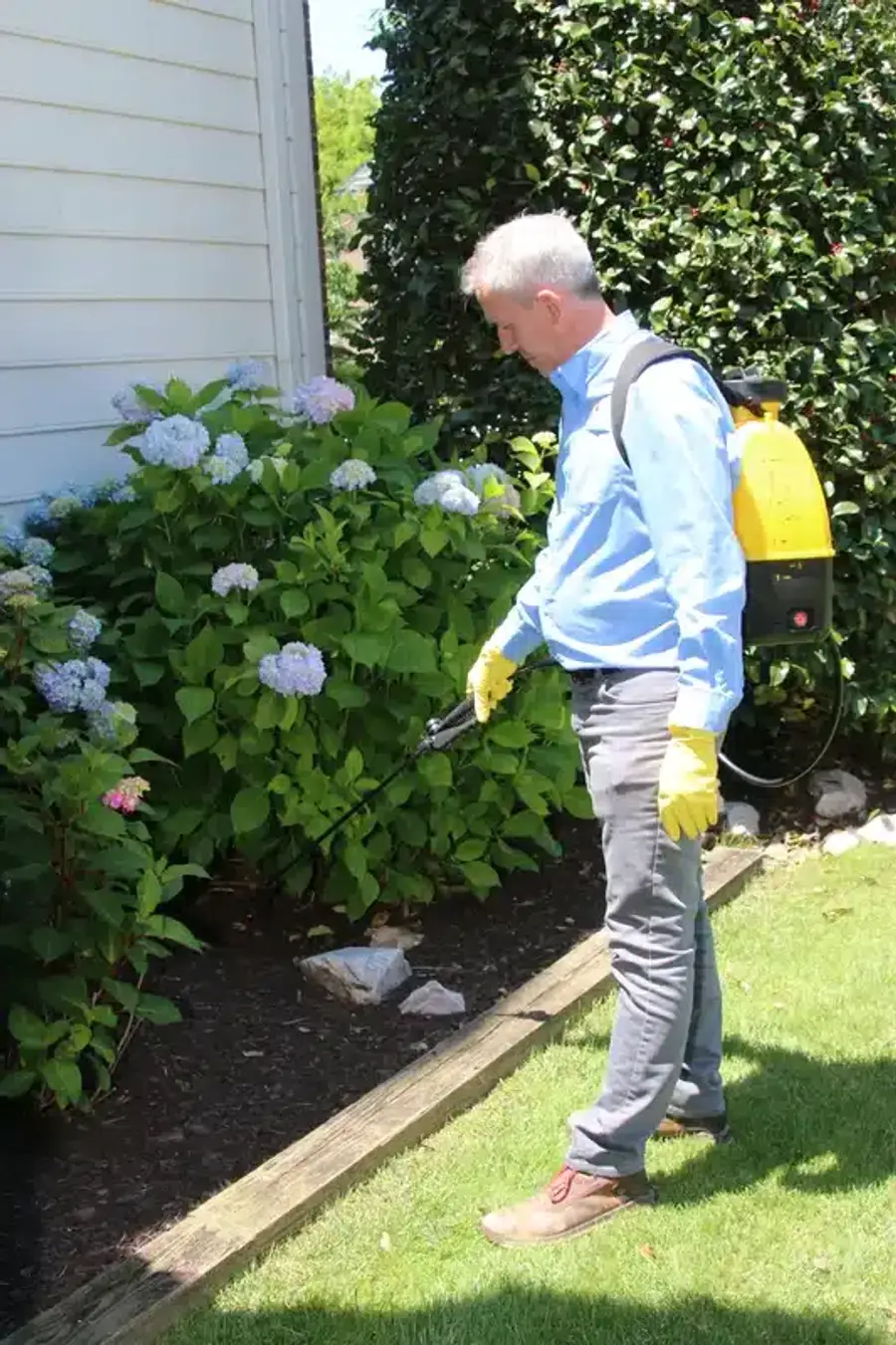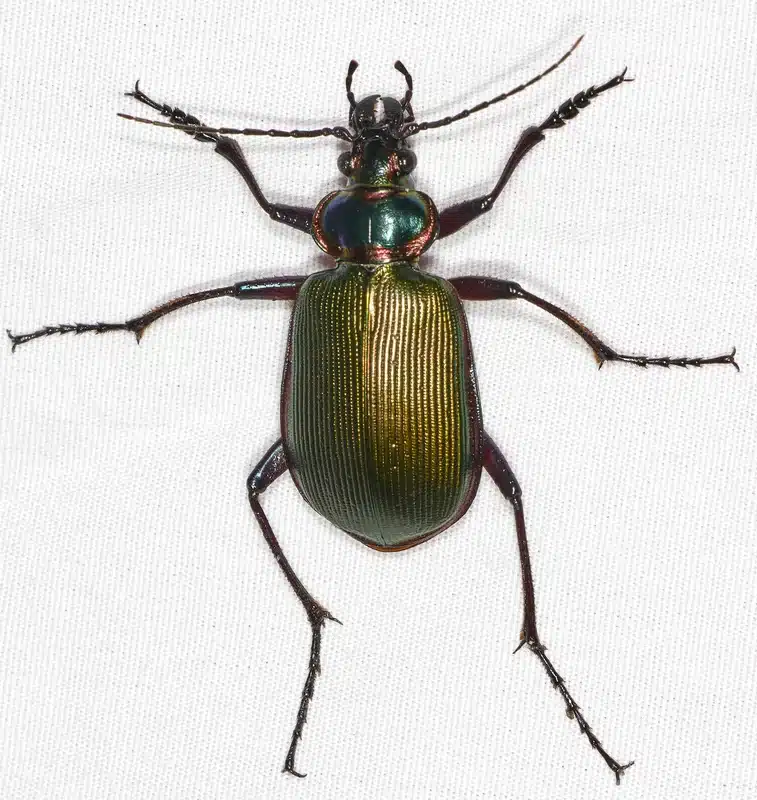Finding shiny black beetles running across your floor at night can be alarming. These fast-moving insects are likely ground beetles, and while they look scary, they’re actually beneficial predators that accidentally wandered into your home. After working in pest control for four years and seeing countless ground beetle situations across the DMV area, I can tell you that understanding these insects is the key to managing them effectively.
Ground beetles don’t damage your home or belongings. They’re simply seeking shelter or got attracted by your outdoor lights. Most homeowners panic when they see them, but these beetles are temporary visitors that can be managed with simple prevention and removal techniques.

What Are Ground Beetles and How to Identify Them
Ground beetles belong to the family Carabidae, which includes over 2,500 species in North America. The ones that typically enter homes in our area belong to genera like Pterostichus, Harpalus, and Scarites. These beetles range from ⅛ inch to 1 inch long and have several distinctive features that make them easy to identify.
Physical characteristics include a flattened body shape, tough ridged wing covers, and a head that’s narrower than their thorax. Most species are shiny black, though some have metallic green, blue, or brassy coloring. They have long, thread-like antennae and powerful legs that make them incredibly fast runners.
What really sets ground beetles apart from harmful beetles is their behavior and body structure. Unlike carpet beetles that have clubbed antennae, ground beetles have straight antennae. Their wing covers meet in a straight line down their back, unlike roaches that have leathery, overlapping wings.


Why Ground Beetles Are Actually Beneficial
Before you reach for the bug spray, consider this: ground beetles are some of nature’s most effective pest controllers. These nocturnal hunters consume massive quantities of harmful insects that would otherwise damage your garden and landscape, including cutworms, slugs, caterpillars, and mosquitoes.
Rather than viewing them as pests, think of ground beetles as free, 24-hour pest control workers. They’re essentially doing the night shift to keep your property free of insects that actually cause problems.
What does the science say?
According to research from the University of Kentucky, ground beetles prey on cutworms, armyworms, root maggots, caterpillars, earworm pupae, mosquitoes, slugs, and snails. Some species consume up to 1,000 weed seeds per square meter per day.
A 2023 study conducted in Virginia’s Shenandoah Valley found that ground beetle activity significantly reduced slug populations in corn and soybean fields by up to 60%, demonstrating their valuable role in natural pest suppression throughout the Mid-Atlantic region.
Common Reasons for Ground Beetle Infestations in Homes
Ground beetles don’t seek out your home as a place to live permanently. Instead, they accidentally wander inside while searching for something else. Understanding these reasons helps explain why you’re suddenly seeing them and how to prevent future invasions.
Seeking Shelter from Weather
Temperature changes drive most ground beetle invasions. During late summer and early fall, these beetles start looking for protected places to wait out the winter. Your warm home seems like an ideal shelter, especially when outdoor temperatures begin dropping below the mid-50s.
Heat and drought also push ground beetles to seek cooler, more humid environments. During particularly hot summers, they may move toward your foundation where sprinkler systems or air conditioning units create moisture.
Attraction to Outdoor Lighting
Many ground beetle species exhibit phototaxis, meaning they’re drawn to light sources. Your porch lights, garage lights, and landscape lighting can attract them from considerable distances. Once they reach your home’s exterior, they often slip through small gaps while trying to get closer to the light.
This attraction to lights is particularly strong during their peak activity periods in late summer and early fall. Bright white LED lights and mercury-vapor bulbs are especially attractive to these beetles.

Accidental Entry Points
Ground beetles in house situations often result from simple accidents. These fast-moving insects can slip through surprisingly small openings while hunting or exploring. Common entry points include gaps under doors, foundation cracks, spaces around utility lines, and unscreened vents.
During our family business’s 50+ years serving the DMV area, we’ve found that most ground beetle problems stem from minor structural gaps that homeowners don’t even notice. A gap as small as ⅛ inch can allow these beetles inside.
Seasonal Patterns: When Ground Beetles Invade
Ground beetle invasions follow predictable seasonal patterns that can help you prepare for and prevent them. Most homeowners in our area see these beetles between August and October, with peak activity occurring during specific weather conditions.
Fall migrations represent the most common time for mass invasions. As outdoor temperatures start dropping, adult ground beetles begin seeking overwintering sites. A warm, wet summer followed by an early cool snap creates ideal conditions for large numbers to appear simultaneously.
According to the University of Minnesota Extension, these seasonal invasions typically subside once temperatures consistently drop below the mid-50s or heavy rains end. However, individual beetles may continue entering homes throughout the winter during warm spells.
In the Virginia, Maryland, and DC area specifically, our humid subtropical climate creates extended activity periods. Warm nights combined with widespread outdoor lighting promotes late-summer flight activity that brings ground beetles to residential areas.
Are Ground Beetles Harmful?
Ground beetles pose virtually no risk to humans, pets, or property. Unlike truly problematic insects, these beetles don’t reproduce indoors, damage structures, contaminate food, or carry diseases that affect people.
The beetles can pinch if you grab them directly, thanks to their large mandibles, but this rarely happens during normal encounters. Some species can also emit a pungent defensive odor or spray when disturbed - this is their natural protection mechanism and isn’t harmful to humans.
This sets ground beetles apart from genuinely concerning household invaders. Unlike carpet beetles that can damage fabrics or roaches that spread bacteria, ground beetles are temporary visitors that cause no lasting problems.
How to Distinguish Ground Beetles from Problem Beetles
Proper identification prevents unnecessary worry and helps you respond appropriately. Several beetle species enter homes, but ground beetles have distinct characteristics that separate them from truly problematic insects.
Carpet beetles are much smaller (less than ⅛ inch), oval-shaped, and have colored scales on their bodies. They fly toward windows during the day and actually damage wool, fur, and other natural fibers. Ground beetles are larger, darker, and primarily active at night.
Pantry beetles like drugstore beetles and cigarette beetles stay near food sources and are usually found in kitchens or pantries. Ground beetles run across open floor areas and don’t show interest in stored foods.
The differences between beneficial and harmful beetles become clear when you observe their behavior. Ground beetles move quickly across floors, rarely fly indoors, and don’t congregate around specific food sources or materials.
Ground Beetles vs Problem Beetles Comparison
| Ground Beetles (Beneficial) | Carpet/Pantry Beetles (Harmful) | |
|---|---|---|
| Size | ⅛ - 1 inch long | Less than ⅛ inch |
| Activity Time | Nighttime | Daytime |
| Behavior | Fast runners | Fly to windows |
| Impact on Home | No damage - beneficial | Damage fabrics/food |
Common Entry Points Around Your Home
Understanding where ground beetles enter helps you focus your prevention efforts effectively. During our inspections across the DMV area, we consistently find the same vulnerable spots that allow these beetles inside.
Foundation and Structural Gaps
Foundation cracks, even hairline ones, provide easy access for ground beetles. Settling joints between foundation sections, gaps around basement windows, and spaces where utilities enter your home create highways for these fast-moving insects.
Weep holes in brick veneer, while necessary for proper drainage, can also allow ground beetles inside if they’re not properly screened. Unsleeved utility lines for air conditioning, irrigation, or cable create additional entry points.
Doors and Windows
Gaps under door thresholds represent the most common entry point we encounter. Even a ⅛-inch gap under a garage door or basement door provides plenty of space for ground beetles to slip inside. Warped door bottoms and worn weather stripping compound this problem.
Ground-level windows, particularly basement windows without tight-fitting screens, allow easy access. During peak activity periods, beetles may climb foundation walls and squeeze through surprisingly small gaps around window frames.
Ground Beetle Prevention Strategies That Actually Work
Effective ground beetle prevention focuses on exclusion and habitat modification rather than chemical treatments. These approaches address the root causes while preserving the beneficial role these beetles play in your landscape.
Sealing Entry Points
Start with a thorough inspection of your home’s exterior, paying special attention to ground-level areas. Install tight-fitting door sweeps and weather-strip garage doors to eliminate gaps. Use mortar or urethane caulk to seal foundation cracks, and stuff copper mesh in weep holes while maintaining drainage.
Screen all vents with hardware cloth that has openings smaller than ⅛ inch. This prevents not only ground beetles but also other occasional invaders from entering through these openings.
Essential Ground Beetle Prevention Steps
- Seal Entry Points: Install door sweeps, caulk foundation cracks, and screen vents with ⅛-inch hardware cloth
- Modify Lighting: Replace bright white LEDs with yellow “bug” lights and use motion sensors
- Create Barriers: Maintain a 2-4 foot gravel band around your foundation to reduce beetle habitat
- Landscape Management: Keep mulch 6 inches from siding and store firewood 20+ feet from walls

Outdoor Lighting Modifications
Since many ground beetles are attracted to lights, changing your outdoor lighting can significantly reduce invasions. Replace bright white LED or mercury-vapor bulbs with yellow “bug” LEDs or low-pressure sodium lights, which are less attractive to insects.
Install motion sensors so lights only activate when needed. Position lighting away from doors and windows when possible, and consider closing blinds at night to prevent interior lights from attracting beetles to your home’s exterior.
Landscape and Habitat Changes
Create a barrier zone around your foundation by maintaining a 2-4 foot band of rock or gravel. This reduces the beetle habitat immediately adjacent to your home while still allowing them to thrive in garden areas.
Keep mulch 2-3 inches thick and at least 6 inches away from your siding. Store firewood and leaf piles at least 20 feet from your walls, and prune dense vegetation that touches your foundation.
How to Remove Ground Beetles from Your House
When ground beetles do make it inside, focus on gentle removal methods that don’t harm these beneficial insects. The goal is getting them back outside where they can continue their important pest control work.
Mechanical Removal Methods
Vacuuming represents the most effective removal method for most situations. Use your regular vacuum to capture ground beetles, then empty the bag or canister outside immediately. The beetles are usually still alive and can be released in your garden or landscape areas.
For individual beetles, use a glass and piece of paper to trap and relocate them. Their fast movement makes this challenging, but it’s possible with patience. Avoid grabbing them directly, as some species can pinch or emit defensive chemicals.
Monitoring and Ongoing Management
Place sticky traps along baseboards in areas where you’ve seen ground beetles. This helps monitor entry points and capture any beetles you might have missed. Check and replace these traps regularly during peak season.
Focus your monitoring efforts on ground-level areas, especially near exterior doors and basement windows. Most ground beetles stay near floor level and rarely climb walls or furniture.


When Professional Ground Beetle Treatment Makes Sense
Most ground beetle situations can be managed with the prevention and removal methods described above. However, certain circumstances warrant professional intervention to address mass invasions or persistent problems.
Mass invasion events - when dozens or hundreds of beetles appear simultaneously - may require professional perimeter treatments. These typically occur during specific weather conditions and can overwhelm homeowner management efforts.
Persistent entry despite exclusion efforts suggests structural issues that need professional assessment. Our registered technicians can identify hidden entry points and recommend comprehensive solutions that address the root causes.
During our decades serving the DMV area, we’ve found that most homeowners can successfully manage occasional ground beetles. Professional treatment becomes valuable when prevention efforts aren’t sufficient or when the invasion scale exceeds practical DIY management.
Understanding Mass Invasion Events
Occasionally, environmental conditions create “perfect storms” that result in hundreds of ground beetles appearing around homes simultaneously. Understanding these events helps homeowners prepare and respond appropriately.
Mass invasions typically occur following warm, wet summers when ground beetle populations are high, followed by sudden cool snaps that trigger migration behavior. Heavy exterior lighting near agricultural fields or woodlots can concentrate beetles from large areas around individual homes.
According to Ohio State University Extension, these events usually subside naturally once temperatures drop consistently or weather patterns change. The beetles aren’t establishing permanent populations - they’re simply seeking shelter in large numbers.
Even during mass invasions, ground beetles remain non-damaging. The primary concern is the sheer number of insects, which can be alarming for homeowners. Professional perimeter treatments during these events focus on creating temporary barriers while the invasion runs its course.
Regional Considerations for the DMV Area
Our Virginia, Maryland, and DC region has specific characteristics that influence ground beetle behavior and management strategies. Understanding these local factors helps homeowners develop more effective approaches.
Common species in our area include the Pennsylvania ground beetle (Harpalus pennsylvanicus), which thrives in the no-till agricultural areas throughout the region. Big-headed ground beetles (Scarites species) are particularly common in the sandy coastal plain areas, while caterpillar hunters (Calosoma scrutator) occasionally climb siding toward lights.
The region’s expanding conservation-tillage acreage in areas like the Delmarva Peninsula and Shenandoah Valley actually supports larger ground beetle populations. This is environmentally beneficial but can increase the likelihood of home invasions during peak migration periods.
Our humid subtropical climate extends ground beetle activity periods compared to northern regions. Warm nights well into fall, combined with widespread outdoor lighting in suburban areas, creates conditions that promote continued beetle activity and potential home encounters.
Long-term Coexistence Strategies
The goal isn’t eliminating ground beetles from your property - it’s managing their interaction with your home while preserving their beneficial role in your landscape. This approach provides the best long-term results for both pest control and environmental health.
Create designated habitat areas in your garden where ground beetles can thrive without conflicting with your comfort. Mulch islands, beetle banks, and maintained brush piles positioned away from your home provide shelter while directing beetle activity away from entry points.
Encourage ground beetle populations in appropriate areas by maintaining diverse plantings and avoiding broad-spectrum pesticides that eliminate their prey base. These beetles will continue providing natural control of other insects that might otherwise require professional management.
Regular maintenance of exclusion measures ensures long-term success. Annual inspections of door sweeps, foundation sealing, and lighting modifications prevent small problems from becoming major invasions.
Understanding ground beetles in house situations comes down to recognizing them as beneficial insects that occasionally wander into the wrong place. With proper identification, prevention, and gentle removal techniques, you can maintain a comfortable home while supporting these valuable pest controllers in your landscape.
If you’re dealing with persistent ground beetle invasions or need help identifying entry points around your home, our registered technicians have the experience to develop effective, environmentally responsible solutions. Call us at 703-683-2000 or email info@bettertermite.com for expert guidance tailored to your specific situation.
Frequently Asked Questions
What attracts ground beetles to my house?
+
Ground beetles are primarily attracted to outdoor lighting and seek shelter from weather changes. They're also drawn to moisture and may accidentally enter while hunting for prey around your foundation. Most invasions occur during late summer and fall when beetles are seeking overwintering sites.
Are ground beetles dangerous to humans or pets?
+
Ground beetles pose no significant risk to humans or pets. They don't bite, sting, or carry diseases. Some species can pinch if handled directly and may emit a pungent odor when disturbed, but these are minor defensive behaviors that cause no lasting harm.
How can I tell ground beetles apart from harmful beetles?
+
Ground beetles are larger (⅛-1 inch), shiny black or metallic, and very fast-moving. Unlike carpet beetles, they don't have clubbed antennae or colored scales. They're active at night and run across floors rather than flying to windows like many problem beetles.
Do ground beetles reproduce inside homes?
+
No, ground beetles do not reproduce inside homes. They require soil for their larvae to develop and cannot complete their life cycle indoors. Any beetles you see inside are temporary visitors that entered from outside.
What's the best way to prevent ground beetles from entering my house?
+
Focus on sealing entry points like gaps under doors and foundation cracks. Change outdoor lighting to yellow "bug" bulbs, maintain a gravel barrier around your foundation, and keep mulch and debris away from your home's exterior.
Should I use pesticides to control ground beetles?
+
Pesticides are rarely necessary for ground beetles since they're beneficial and temporary visitors. Focus on exclusion and removal methods instead. If professional treatment is needed for mass invasions, targeted perimeter applications can be effective while minimizing impact on beneficial insects.
How do I remove ground beetles that are already inside?
+
Use a vacuum to capture ground beetles, then empty the contents outside where they can be released. You can also use a glass and paper to trap individual beetles for relocation. Avoid handling them directly to prevent pinching or defensive odor release.
When is ground beetle season in the DMV area?
+
Ground beetle invasions typically peak from August through October in Virginia, Maryland, and DC. Late summer warmth followed by cooling temperatures triggers migration behavior that brings them near homes seeking shelter.
Why should I tolerate ground beetles on my property?
+
Ground beetles are valuable predators that consume harmful insects like cutworms, slugs, caterpillars, and mosquitoes. They also eat weed seeds and provide natural pest control that reduces the need for other interventions. They're essentially free, 24-hour pest management workers.
When should I call a professional for ground beetle problems?
+
Consider professional help for mass invasion events with hundreds of beetles, persistent entry despite exclusion efforts, or when you need help identifying and sealing entry points. Most individual beetle encounters can be managed with DIY prevention and removal methods.
With five years of hands-on experience in the pest control industry, George Schulz is a registered technician with the Virginia Pest Management Association and a proud third-generation professional in a family business that's been protecting homes for over 57 years. He manages and trains a team of service pros while also leading internal research efforts—recently spearheading a deep-dive review of thousands of documents on pest control materials to hand-pick the most kid and pet friendly, most effective solutions tailored specifically for homes in the DC metro area.
